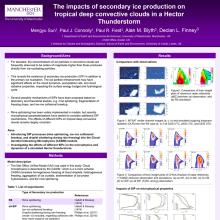The impacts of secondary ice production on tropical deep convective clouds in a Hector thunderstorm
Mengyu
Sun
Department of Earth and Environmental Sciences, University of Manchester
Poster
For decades, the concentrations of ice particles in convective clouds are frequently observed to be orders of magnitude higher than those produced directly from ice-nucleating particles (Cantrell and Heymsfield, 2005). This reveals the existence of secondary ice production (SIP) in addition to the primary ice nucleation. To evaluate the impacts of SIPs on tropical convective clouds, the Met Office Unified Model with the Cloud-Aerosol Interacting Microphysics Module (CASIM) was employed in this study. We first attempt to implement different SIP mechanisms (riming splintering, freezing raindrop shattering, and ice-ice collisional breakup) in the CASIM module, before we use it to simulate a Hector thunderstorm that occurred in the north of Darwin, Australia (Connolly et al. 2013). Preliminary results suggest that the UM can generally catch the vertical structure of clouds during this storm. The simulated anvils are not as extensive as the observed anvil; however, the simulation including all SIPs produces an anvil that is the most extensive at higher levels, compared with other simulations. Results show the importance of SIP in the enhancement in number concentrations of graupel particles and raindrops, although the model produces too much ice crystals with these new SIP mechanisms. More sensitivity studies will be conducted to investigate whether the current SIP schemes produce too much ice or the conversion of ice crystals between categories leads to this phenomenon. The impacts of SIPs on the dynamics of tropical convection will also be assessed.

mengyu-sun-poster.pdf
(1.12 MB)
Meeting homepage
